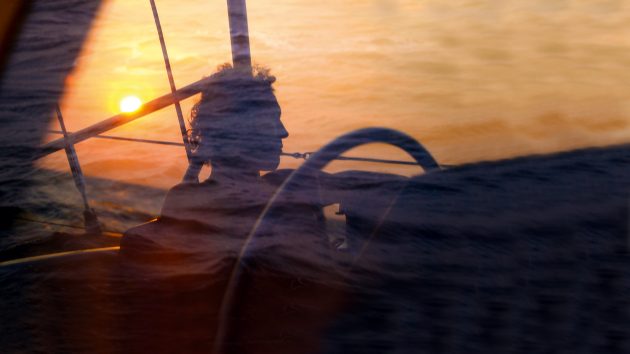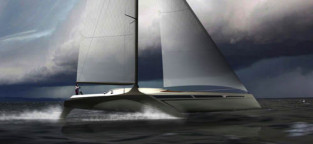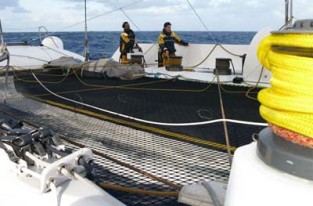With all ports across the Pacific closed, Carlos Cuadrado faced a 3,400-mile non-stop solo passage to make it home to Australia
The tireless whirring of my coffee machine brought me back to my senses as I stood, lost in thought, in the cockpit of Mirniy Okean, my 40ft Boden South Sea steel ketch. I watched the sun rise over Bora Bora knowing that today was checkout day: I was about to begin a solo passage to Australia, across the Pacific in full Covid lockdown.
All the islands between Bora Bora and home were closed, except for Fiji, which I’d decided to skip due to the high entry fees to get in. That means sailing 3,400 miles non stop, and I’m not ready for this.
Maybe it’s the more than 30,000 miles I’ve sailed since I embarked on this journey, or the knowledge that after this passage my dream of circumnavigating is over, but something inside me has changed. Going back to ‘normal life’ is not going to be easy. I’ve been living life to the fullest for five years.
I set off from Australia in 2017, having made the decision to sail around the world after competing as a professional tennis player, and then working for the Australian National Tennis Academy. One day, with no previous experience, I sold everything I had, bought a boat and set off. Over three years I crossed the Indian Ocean, rounded the notorious Cape of Good Hope, and transited the Panama Canal before arriving in French Polynesia. Now it was time to complete the circle.

Carlos Cuadrado at the helm. Photo: Linda Terii
I motor my dinghy to shore and start walking to the gendarmerie, but I can’t go in. I’m struggling to come to terms with my journey coming to an end, and I fail to hold back tears. My heart is telling me to stay but my mind is pushing me to go. Somehow I find peace halfway, promising myself that one day I’ll be back and I just have to get the immigration process done. With my passport stamped there’s no turning back.
Pacific immersion
Sailing is the excuse I use to experience the challenge of crossing oceans, but my deeper drive is to integrate myself into the native cultures of the isolated places I sailed into. Researching the history, geography, and culture of the places I have visited became one of my main activities as I planned my circumnavigation.
In March 2021 I was lucky enough to be able to explore three of the eight beautiful islands of the Marquesas: Nuku Hiva, Tauata and Fatu-Hiva. The Marquesas left a lasting impression on me. I relished learning about their powerful cultural dances, skilful artisans, the complex history of their tattoos, and the love and generosity of the people. It will always be a very special place to me.

South seas island anchorage in Moorea.
After spending four months in the Marquesas it was time to start moving westwards, and a weather window of easterlies gave me a perfect wind angle for the four-day passage to Fakarava, part of the Tuamotus Islands. Ten days in Fakarava passed in the blink of an eye. I experienced an exhilarating dive of the famous South Pass with more than 300 sharks, and spent my days diving and learning to spearfish with other sailors.
Next was Tahiti, 280 miles to the south-west. Tahiti was a different experience to the rest of Polynesia: even if it is easy to get away to find unspoilt nature, the centre feels like any other busy and noisy city. The positive of this is there are plenty of shops to restock and buy or fix parts. I also spent six weeks working with the Tahitian Tennis Federation helping athletes and coaches with their high performance programme. I’ve been very lucky in my tennis career to be exposed to great mentors and I loved passing on my experience in Tahiti.
From Tahiti I sailed to Moorea, Huahine, Taha’a and, in what would be my last stop before the big crossing, Bora Bora. Bora Bora had no tourists because of the pandemic, becoming instead one giant playground for sailors. I was going to miss this life.

Scuba diving with sharks in Fakarava’s South Pass. Photo: 1000amares
When the day for departure arrived, I faced this passage like any other, with a spice of fear and respect for the ocean that translates into excitement and caution. The previous days spent getting the boat ready I prepared just as I did for my days on the tennis court: I visualised the problems that could arise and created a game plan, then I made sure I had everything I needed to solve problems ready to go.
Mirniy Okean has taken me around the world without complaint, it has nurtured me and kept me safe. I put my hand on top of the compass and whispered, ‘One more time, baby, one more time.’
Article continues below…
Cruising at Warp Factor 10
Imagine cruising across the Pacific at 40 knots!
Gitana 13 attacks North Pacific crossing
11-man crew leave San Francisco in a bid to reach Japan in record time 31/3/08
I made final preparations for food, gas and water and checked every system on the boat. My competitive mentality loves challenges and once I could put all my emotions to one side, I started to feel excited again for my next ocean passage.
I emailed the Australian Border Force of my estimated time of arrival and port of entry, and made a passage plan that put me well away from the many islands and reefs that dot this route. I studied patterns of weather windows and systems – it looked like the low pressures from New Zealand were a bit higher than normal. That pushed my decision to get away from the rhumbline and give Fiji a wide berth. It would definitely add more miles to the passage, but since I was alone, comfort and safety were top of my priority list.
Heading off
I left Bora Bora on a sunny afternoon at the end of a high pressure, giving me 15 knots of east-north-easterly winds for the next four days. Setting a course for 270° I set off making a pleasant 6.1 knots on a starboard tack. Then, after 500 miles and four days, the wind disappeared.
I could choose to use the engine, or simply float until the next winds pushed me towards my destination. With more than 3,000 miles to go, and conscious of the need to save fuel, I chose the second option. I doused the sails and drifted at 0.3 knots while taking some time to sleep and cook good meals, had a proper shower and made some fresh water.

Taihoe Bay, Nuku Hiva in the Marquesas. Photo: Linda Terii
After floating for 24 hours I made the most of the super-light winds and poled out a genoa, picking up to 2.5 knots speed over ground which, if not very fast, is better than nothing and still gained me 60 miles over the next 24 hours. By day seven, the wind was back, progressively building until it reached a solid 25-30 knots and guaranteed a fast passage for the week ahead. With it there was a 3-5m sea with an eight second wave period on the beam, which made the passage bumpy and uncomfortable.
At night, if there’s no moon or it’s too cloudy to see the squalls approaching, I normally reef from midnight until first light. If a squall comes in before midnight I’m still awake enough to put in a reef in three minutes, and if it comes after first light I’d see it with enough time to reef early. Every time I reefed, I gained in safety and comfort but lost around 0.5 knots of boatspeed, which equates to a lot of time over 3,000 miles.
After 14 days of passage I’d passed Fiji and with a solid high pressure generating consistent winds in the mid-20s from the south-east, it looked a good opportunity to change course to 235°, sailing south-west and aiming for the southern tip of New Caledonia’s Isle of Pines at 7 knots. With a little bit of favourable current I managed to log a few days sailing over 150 miles in 24 hours, and relished the sense of making good progress. It was hard to believe I had been on this same island four years ago, learning to sail as I went.

When conditions allowed Mirniy Okean could achieve 7 knots and cover more than 150 miles in 24 hours. Photo: Linda Terii
Thunderous welcome
Two weeks of solo sailing in, and I was starting to feel tired. Fatigue is something I’m used to from my days on the gruelling professional tennis circuit, but this tiredness was more mental than physical due to the sea state. Mirniy Okean was being hit by huge tropical squalls that hit peak wind speeds of 40-plus knots, and my sleep patterns were all over the place. My alarm was set for every 40 minutes, but I couldn’t manage to sleep even that much. My body didn’t know whether it was breakfast or dinner time, so I ate when I felt like it.
I have to admit, however, that I get excited when things don’t go easily; it must be my competitive personality constantly looking for a challenge. On day 20, somewhere between New Caledonia and the Australian Coast, there was a loud bang and I went out to find the block that holds the vang totally destroyed. I smiled to myself that of course this had to happen at night.
I hove-to, giving myself a few minutes to work out what to do. Then I grabbed my cordless grinder, thankful that I’d remembered to charge it before setting off, took a metre of Dyneema rope and my head torch, clicked my harness to the safety line and prepared to step outside the cockpit. With the boat rolling so much, I had to try my hardest not to cut myself, but managed to round off all the corners of the broken block and reattach it with Dyneema. It worked a treat.
I reset the boat back on course and the alarm for 40 minutes of sleep with a big smile, having realised that I’d not have been able to do something like that four years ago without screaming with frustration.
With 600 miles until Australia the wind disappeared once again. We had averaged 6.2 knots until then, so it didn’t seem fair to complain after the good three week run we’d just enjoyed. After considering all scenarios, this time around I took a different approach. Strong low pressure systems from Australia are not uncommon at that time of the year and one coming my way would be less than ideal. I put the engine on and we kept making progress. Three hundred miles later the winds returned, and I found myself sailing once again at nearly 7 knots.

Cuadrado was able to put in a reef solo in just three minutes. Photo: Linda Terii
There have been just two nights on this circumnavigation when I’ve been scared: the first was the very first day I bought my yacht in New Zealand, facing a huge storm in Cook Strait. The second was the final night before arriving in Australia.
Just 60 miles from land I was surrounded by lightning, the sky illuminated every 10 seconds. Having had a broken radar for two years, I had been facing storms without data since 2019, when I was sailing from Madagascar, but this one seemed like a big one. I told myself one more time that it will pass, but it didn’t.
Although I can’t believe this is happening on my last night at sea, I have to make the decision to avoid it and divert our course. The problem is that I can’t really see which direction it’s moving, and it seems that wherever I go the storm is chasing me.
I hove-to once again, trying to see the direction of the storm and hoping it will miss me. When it becomes clear the storm is heading straight towards me, I make a 180° change of course and simply try to get out of there as soon as possible. I was afraid we’d get hit by lightning so I put all the electronics I could in the oven, hoping the advice I read years ago in a tattered sailing magazine was sound. I reefed the mainsail as much as possible and rolled the genoa away. After four years around the world it was finally time to hoist the storm jib.
I managed to pass right along the edge of the storm, although the winds still reached more than 50 knots. After riding the margins of the storm for six hours, as nothing major was damaged apart from a broken UV strip on the storm jib. I sat down heavy with relief.
The difference between that first night in Cook Strait and the final night is that I wasn’t panicking, which allowed me to think more clearly and make smarter decisions. Sailing makes you earn every mile, and managing stress and fear becomes part of the process of learning. There are no shortcuts, and I wouldn’t want it any other way.

Cuadrado arrived in the Marquesas in spring of 2021. Photo: Linda Terii
Home at last
Next morning was like nothing had happened, and I was sailing a perfect beam reach on a sunny day approaching the Gold Coast – feeling absolutely exhausted. Just before I went to drop the sails I spotted a splash in the water.
I reached for my camera and saw two humpback whales breaching and slapping their tails just metres from the bow. Whales make those sounds to communicate with others many miles away. I don’t believe in coincidences, but the ocean has made me believe in magic. I felt deep inside that, just perhaps, the whales were sending a message to the ‘other side’, telling my late father of my safe arrival home. In that moment I felt deeply connected to my father, from whom I learned a love for the ocean, and who I know would be proud I followed my dreams.
I finally let down the sails after 28 days at sea: I’d completed the passage single-handed, but realised that I’d never sailed truly alone.
 If you enjoyed this….
If you enjoyed this….
Yachting World is the world’s leading magazine for bluewater cruisers and offshore sailors. Every month we have inspirational adventures and practical features to help you realise your sailing dreams.Build your knowledge with a subscription delivered to your door. See our latest offers and save at least 30% off the cover price.






